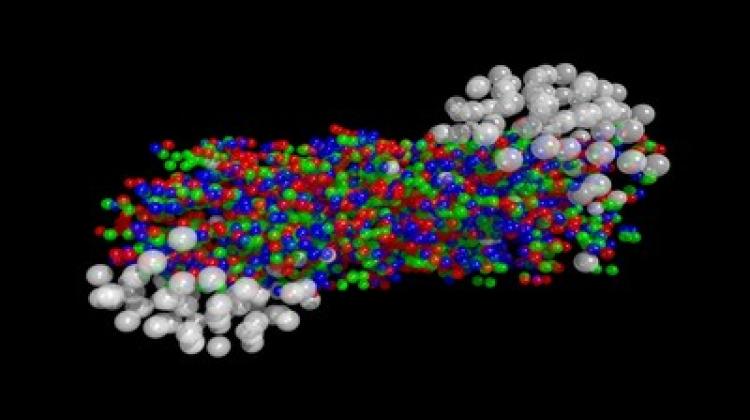The most exotic fluid is not as viscous as expected

Volume viscosity of the quark-gluon plasma generated by the LHC accelerator is much lower than previously expected - according to a new theoretical model presented by physicists from Poland and the US.
Collisions of lead nuclei in the LHC occur at such high energies that quarks, which are usually trapped in protons, are released and, together with their gluons, form a stream of exotic fluid: quark-gluon plasma. According to the new, much more detailed theoretical model of this plasma, it has a much lower viscosity than previously estimated. The new model has been developed by researchers including scientists from the Institute of Nuclear Physics PAS in Kraków. The institute informed about the research in a release sent to PAP.
The world we know from everyday experiences consists of objects built mainly of protons and neutrons. These particles, in turn, contain three quarks, bonded by strong interactions carried by gluons. The characteristic feature of strong interactions is that, unlike gravity, their force increases as the distance increases. That\'s why quarks behave as if they were bound with springs, the more we try to pull them apart, the more they try to stay close to one another.
The energies of the particles accelerated inside the LHC are so great that, during the collisions, quarks are released from protons. A short-lived quark-gluon plasma is produced - as the researchers from the Institute of Nuclear Physics PAS say - "without doubt the most exotic fluid tested in Earth laboratories". Until now researchers thought that it was quite viscous - but the conclusions of scientists from the Institute of Nuclear Physics PAS in Kraków and Kent State University in Kent (Ohio, USA) are different.
"In physics, flows are described with hydrodynamic equations" - explained Dr. Radosław Ryblewski from the Institute of Nuclear Physics PAS. "When we use the simplest versions of these equations for quark-gluon plasma, the predictions are fairly consistent with measurements collected during the LHC collisions. At first glance, quark soup actually seems to behave according to simple expectations. But when we look at the details, it becomes evident that we are dealing with a very complex phenomenon" - he added.
The catch is that the mathematical description of liquid becomes simplest with the assumption that the liquid is perfect - devoid of viscosity. But perfect liquids do not exist in nature. Therefore, to improve the accuracy of predictions, various corrections are made to the hydrodynamic equations. The resulting variants of liquid hydrodynamics, however, are based on further assumptions, for example, that the liquid pressure changes equally in all directions.
"The problem is that quartz-gluon plasma is produced in the LHC in a very specific way, as a result of collisions of lead nuclei coming in one direction at speeds close to the speed of light" - said Dr. Ryblewski. For this reason, the liquid formed from quarks and gluons initially also moves along the direction of the stream. Only later it begins to cool and thin.
"When creating a model, the scale of challenges increases when we try to account for the fact that at the beginning of the process we have a different liquid than at the end - after cooling the quarks gradually start to stick together again!" - added Dr. Ryblewski. "That is why, together with Professor Wojciech Florkowski, at our institute we started to develop a more detailed model of the phenomenon: anisotropic hydrodynamics, based on the assumption that the described system does not behave the same way in all directions".
According to the Institute of Nuclear Physics PAS, the researchers have just presented the latest theoretical model, constructed based on anisotropic hydrodynamics, in an article published in the Physical Review Letters (https://doi.org/10.1103/PhysRevLett.119.042301).
According to analyses conducted by Polish and American scientists, the volume viscosity of the quark-gluon plasma (not to be confused with the shear viscosity between the layers of flowing fluid) is six times lower than the numerical predictions of other models based on the viscous liquid hydrodynamics.
Unlike other models, the equations presented in the new article can be solved with practically any accuracy - emphasize the physicists. By compiling their predictions with data from other models and confronting them with actual measurements in the ALICE experiment at the LHC, the Polish-American team has shown that anisotropic hydrodynamics is currently the most accurate description of the phenomena occurring in quark-gluon plasma.
PAP - Science and Scholarship in Poland
author: Katarzyna Florencka
kflo/ ekr/ kap/
tr. RL
Przed dodaniem komentarza prosimy o zapoznanie z Regulaminem forum serwisu Nauka w Polsce.















